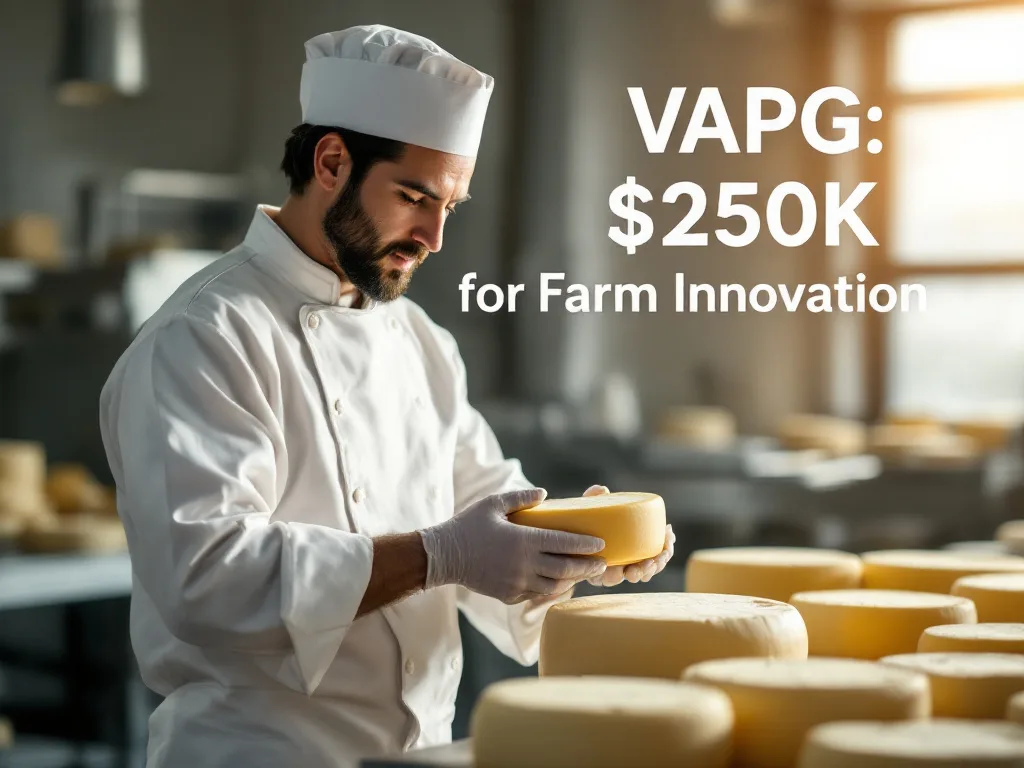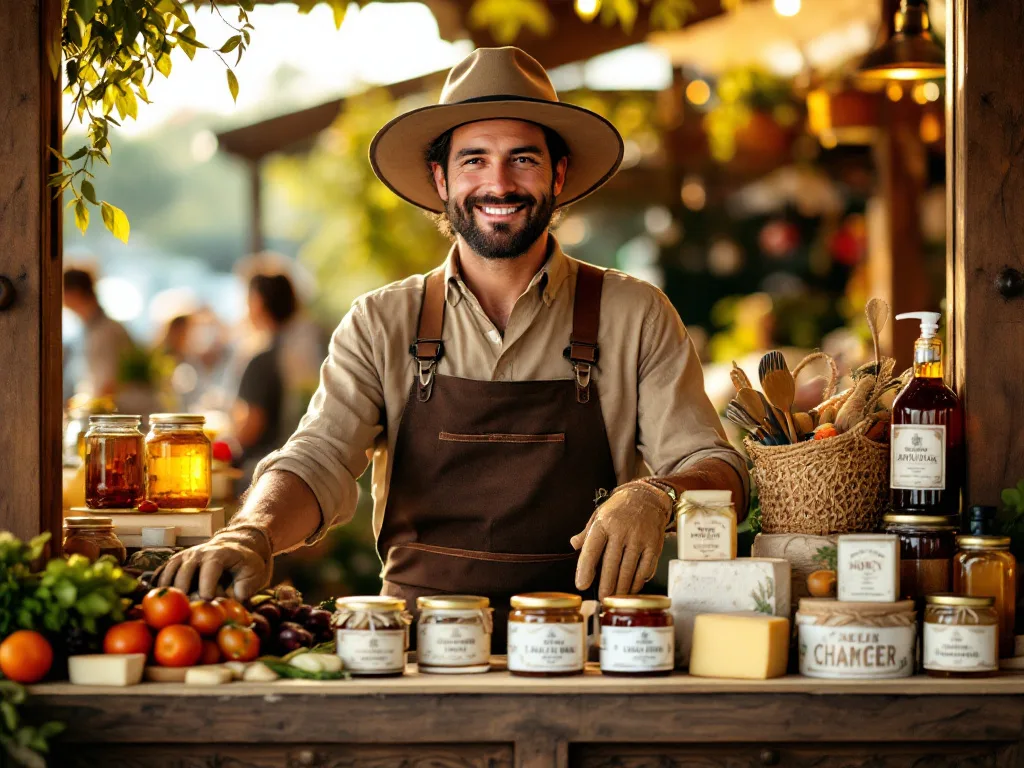Key Takeaways
VAPG recipients demonstrate 89% higher business survival rates over two years
Program offers up to $250K for transforming agricultural products
Small family farms receive priority status and enhanced funding chances
Value-added processing can increase product revenue by up to 300%
Complete Guide to $250K Funding
In today’s evolving agricultural landscape, the difference between survival and success often lies in your ability to transform raw farm products into premium value-added goods. The USDA’s Value Added Producer Grant (VAPG) program, backed by $30 million in funding, offers agricultural producers a powerful opportunity to innovate and expand their market reach. This comprehensive guide will walk you through everything you need to know about securing and maximizing VAPG funding.

Understanding the VAPG Advantage
The VAPG program isn’t just another funding source – it’s a transformative opportunity that has proven its worth. Research shows that businesses receiving VAPG support are 89% more likely to survive their first two years compared to non-recipients. This remarkable success rate stems from the program’s comprehensive approach to agricultural innovation.
While many grants focus solely on production, VAPG’s emphasis on value-added activities creates sustainable competitive advantages that continue generating returns long after the grant period ends.
Defining Value-Added in Modern Agriculture
The USDA takes a broad, forward-thinking approach to value-added agriculture. At its core, value-added activities transform your raw agricultural products into something more valuable in the marketplace. This transformation can take several forms:
Physical transformation stands as the most straightforward approach – turning milk into artisanal cheese, fruits into premium preserves, or grains into specialty flour. However, value-added opportunities extend far beyond physical processing.
Marketing enhancements, such as organic certification or grass-fed verification, can significantly increase product value without changing the physical product. Local food promotion and physical segregation strategies help producers capture premium prices through strategic positioning. Some innovative farmers even explore farm-based renewable energy projects, turning agricultural byproducts into valuable energy resources.
The most successful VAPG projects often combine multiple value-added strategies. For example, an organic dairy farm producing artisanal cheese leverages both physical transformation and marketing enhancement to maximize value creation.
Funding Options and Strategic Choices

VAPG offers two distinct funding tracks, each designed to support different stages of value-added enterprise development:
Planning Grants: Building Your Foundation
Planning grants, offering up to $75,000, support the crucial groundwork for your value-added venture. These funds help you:
- Conduct comprehensive market research
- Develop detailed business plans
- Create marketing strategies
- Complete feasibility studies
- Design product packaging and branding
Working Capital Grants: Bringing Your Vision to Life
Working capital grants provide up to $250,000 to implement your value-added project. This funding covers:
Processing costs
Marketing and advertising campaigns
Inventory management
Salary expenses for project personnel
For working capital grants under $50,000, USDA offers a simplified application process that doesn’t require a feasibility study. This creates an excellent entry point for first-time applicants or smaller projects.
Maximizing Your Eligibility and Priority Status

The VAPG program employs a sophisticated prioritization system that can significantly impact your chances of success. Understanding and leveraging these priorities is crucial for developing a competitive application.
Core Eligibility Requirements
To qualify for VAPG funding, you must demonstrate:
Ownership and production of over 50% of your raw commodities
At least one year of documented sales history
Ability to provide matching funds
Appropriate business structure (independent producer, agricultural group, or cooperative)
Document everything meticulously. Applications with comprehensive proof of eligibility receive priority in the review process, while those with gaps often face delays or rejection.
Priority Status Enhancement
The VAPG program particularly values certain agricultural demographics, offering enhanced consideration to:
Beginning farmers and ranchers stand at the forefront of agricultural innovation. These entrepreneurs, defined as those operating for 10 years or less, bring fresh perspectives and contemporary approaches to value-added agriculture. The USDA recognizes their potential by offering them priority status in the application process.
Socially disadvantaged producers receive similar priority consideration. This includes farmers and ranchers who have faced historical barriers in agriculture, ensuring the program supports diverse agricultural development across all communities.
Veteran farmers represent another key priority group. Their unique skills and leadership experience often translate into successful agricultural enterprises, and the VAPG program actively supports their transition into value-added agriculture.
Applicants qualifying for multiple priority categories should thoroughly document each status. This multiplier effect can significantly enhance your application’s competitive position.
VAPG Eligibility Checker
Answer a few questions to check your eligibility for the USDA Value Added Producer Grant
Crafting a Winning Application Strategy

The difference between successful and unsuccessful VAPG applications often lies not in the quality of the agricultural product, but in the strategic approach to the application process. Let’s explore the key elements that set winning applications apart.
Market Analysis and Business Planning
Successful VAPG applications begin with comprehensive market research. This isn’t just about gathering data – it’s about telling a compelling story of market opportunity and business viability. Your application should demonstrate:
A deep understanding of your target market’s size and characteristics Clear evidence of customer demand and willingness to pay premium prices Competitive analysis showing your unique value proposition Realistic projections for market penetration and growth
The business planning section must bridge the gap between market opportunity and execution strategy. Include details about:
Your production capacity and scalability plans Distribution channels and partnerships Marketing strategies and brand development Financial projections grounded in market realities
Include primary market research whenever possible. Direct customer surveys, focus group results, and letters of interest from potential buyers carry more weight than general market statistics.
Financial Strategy and Matching Funds
VAPG requires a one-to-one match of grant funds, but smart applicants view this as an opportunity rather than a burden. Your financial strategy should:
Demonstrate clear sources for matching funds Leverage in-kind contributions effectively Show sustainable cash flow projections Include contingency planning
Up to 25% of your matching requirement can come from in-kind contributions, including your own time and effort. Document these contributions meticulously with prevailing market rates for similar services.
Implementation Excellence and Reporting Success

Securing the grant is just the beginning. Successful implementation requires careful planning and diligent execution. Here’s how to ensure your project succeeds:
Project Management Framework
Develop a robust project management system that includes:
Clear milestones and deliverables Regular progress monitoring protocols Resource allocation plans Risk management strategies
Your implementation plan should demonstrate how you’ll:
Track progress against objectives Manage budget and resources effectively Document outcomes and impacts Adapt to challenges and opportunities
Create a detailed project timeline with specific metrics for each milestone. This not only helps with implementation but also strengthens your application by showing thorough planning.
Maintaining Compliance and Documentation
Successful VAPG implementation hinges on maintaining meticulous documentation and reporting practices. Here’s what you need to know about staying compliant:
USDA requires regular reporting on both financial and performance metrics. Your reporting schedule will typically include:
- Quarterly financial statements detailing grant and matching fund expenditures
- Semi-annual performance reports highlighting project milestones
- Annual comprehensive reviews of project impact
- Final project evaluation documenting outcomes and lessons learned
Create dedicated spreadsheets for tracking both grant and matching fund expenses from day one. This proactive approach will save countless hours during reporting periods and ensure you maintain compliance.
Success Stories and Impact Analysis
The real power of VAPG becomes evident through success stories across the agricultural sector. Consider these inspiring examples:
The Mill at Janie’s Farm in Illinois used their VAPG grant to transform their organic grain operation into a regional milling powerhouse. By investing in marketing and product development, they now supply premium flour to bakeries across the Midwest, increasing their revenue by 285% within two years.
In Wisconsin, Doudlah Farms leveraged VAPG funding to transition 1,800+ acres to organic production and develop innovative branded products. Their success extends beyond their farm – they now serve as a model for sustainable agriculture, sharing their practices at conferences nationwide.
Success stories demonstrate that the most impactful VAPG projects often create ripple effects, benefiting both the grant recipient and the broader agricultural community.
Frequently Asked Questions
Get detailed answers to common questions about the USDA Value Added Producer Grant program
Planning grants (up to $75,000) fund preparatory activities like market research and business planning, while working capital grants (up to $250,000) support actual implementation and operations.
The 1:1 match is non-negotiable, but you can use a combination of cash and in-kind contributions. Up to 25% can come from in-kind sources like your own labor.
Yes, beginning farmers (operating for 10 years or less) receive priority status, though you must have at least one year of sales history.
Activities include physical processing, marketing enhancements, local food promotion, and farm-based renewable energy projects. The key is demonstrating increased value and market expansion.
Typically, plan for 60-90 days to prepare a competitive application. Working capital grants over $50,000 require additional time for feasibility studies.
No, but you can use funds for equipment rental or contracted services that use required equipment.
Any costs exceeding the grant amount are your responsibility. Careful budgeting and regular monitoring are essential.
No, you must complete and close out one VAPG project before applying for another.
Applications are evaluated on technical merit, priority categories, project viability, and potential rural impact.
USDA provides technical assistance through state Rural Development offices, and organizations like Grantaura offer specialized application support.
Conclusion: Your Path to Value-Added Success
The Value Added Producer Grant represents more than just funding – it’s a catalyst for agricultural innovation and business transformation. With proper planning, thorough documentation, and strategic execution, VAPG can help you turn your value-added vision into reality.
Success with VAPG requires attention to detail, strong market understanding, and careful planning. Whether you’re considering a planning grant to explore new opportunities or a working capital grant to scale existing operations, the key lies in presenting a compelling case for how your project will create sustainable value.
Partner with Grantaura’s expert team to maximize your VAPG application success. Our specialists understand the nuances of the program and can help you develop a winning proposal that aligns with USDA priorities while advancing your business goals.

